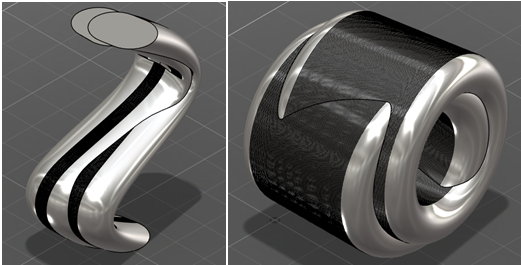 |
Articles
10 Feb 2014 Autodesk Core 1.0: Successor to ShapeManager, or Toy for Enthusiasts?ShapeManager still lacks parallelization capabilities. Maybe Core kernel can helpNikolay Snytnikov Ralph Grabowski in his article “Introducing Core, Autodesk's Other Solid Modeling Kernel” drew attention to the re-branded Gen6 geometric kernel, the technology used inside TinkerCAD's Web-based CAD system acquired by Autodesk in 2013. Along with the re-branding, Autodesk introduced Creative Platform based on the TinkerCAD API, which is supposed to be extended by contributions from the community. Autodesk says the platform and Core kernel are applicable for other offerings in its ecosystem of consumer products. So Creative Platform is not restricted only for use in TinkerCAD.
TinkerCAD’s Gen6 (now Autodesk Core 1.0) is interesting to the CAD world, because (a) it was designed to run in a cloud environment using clusters of servers, and (b) it is a voxel-based [3D-volume element] solid modeler, whereas other modern commercial modelers use B-Rep [boundary representation] solids. Voxel-based representations and algorithms are ideally suited for scaling up to hundreds and thousands of processors. However, they lack sufficient accuracy to represent CAD models. Without a significant improvement by Autodesk, Core can be used only for niche solutions in education and 3D printing, where the accuracy requirement is weaker. Further details on this subject and a discussion of parallelization in other kernels (Parasolid, ACIS, CGM and the recently developed RGK, Russian Geometric Kernel) can be found in the article Evolution and Revolution.
So why would Autodesk need to develop a cloud software platform based on a new kernel? Probably because the time-proven ACIS-based Autodesk ShapeManager (ASM)does not sufficiently support parallel computation.
It does, however, have multithreading, such as multithreaded Boolean operations, as announced at least a year ago. (See Grabowski’s report following the Autodesk University 2012 press-conference.) But there is no evidence that the capabilities are available to end-users today.
This is easy to verify with ShapeManager-based applications such as Inventor Professional 2014 and Fusion 360. Both CAD applications are installed locally on the PC and use the most recent version of ASM. For example, in scenarios consisting of the Boolean union of two bodies with many intersecting faces, solving the Booleans takes 2-3 minutes on today's typical 4-core PC. (See the figures below.) The Windows task manager utility reports that only one processor core is employed by each application. When we compare their performance with another geometric kernel that explicitly supports multithreading, we see that the latter is significantly faster, because it uses all processor cores during solving.

Left: Two identical bodies with 20 NURBS faces each, with one rotated by a small angle are unioned.
Right: Two identical bodies with dozens of torus-based faces.
It should be noted that scenarios in the design office are for the most part simpler than our test cases, and so are executed instantly even on single-core machines, without the need for parallelization. Other times, however, performance becomes critical when end users work with large models containing a considerable number of faces. This then becomes a case for running CAD computations on cloud environments, performing all computations with CAD applications installed on remote servers. (For example, Autodesk's 3D design running in a browser powered by OTOY software and NVIDIA hardware, and installed on the Amazon Web Services environment.) When a seemingly-powerful remote server with hundreds of processors/cores doesn’t respond instantly to the user's request, then frustration comes.
By the way, speaking of Autodesk’s 3D design system in a browser, announced November 2013, I was disappointed when I could not launch any of the supported applications in my browser. As it turned out, it is not for anyone. We can use OTOY technology with Autodesk's applications only by choosing the appropriate GPU hardware (NVIDIA Grid) from the list of Amazon’s available hardware configurations. And to be allowed to choose this hardware, we must have a sufficient client history, i.e. paying bills to Amazon for some time. I think the problem is that Amazon didn’t install enough NVIDIA Grid GPUs in its servers, so it is forced to restrict the number of users. So, it’s not easy to test the browser version of Autodesk software, but I believe that the capabilities of ShapeManager will not be different on this version.
If ShapeManager doesn’t support multithreading, then there are a lot of work for the development team to do to adapt it to the cloud. And so perhaps this is what Autodesk wants to do: run the new Creative Platform as an experiment of how a cloud-based CAD system can be used by a community of enthusiasts, and the way by which it will be extended. Depending on the results of this experiment, Autodesk might either develop the Core kernel further or else introduce parallelization to ShapeManager. In the case of further development of Core, must first improve the voxel-based approach, as well as solve the precision issue. In any case, either kernel requires non-trivial algorithmic problems of geometric modeling solved.
Here at LEDAS, we have already begun similar R&D projects, inspired by our participation in the RGK (Russian geometry kernel) project. One of our projects is aimed at developing a scalable geometric kernel for the cloud environment. Such a kernel is efficient at deploying all resources available from powerful computing environments with their dozens or hundreds of processors, and so is able to handle tasks involving native B-Rep data of any complexity, instantly, without compromising accuracy.
See also:
Permanent link :: http://isicad.net/articles.php?article_num=16761

|
 |